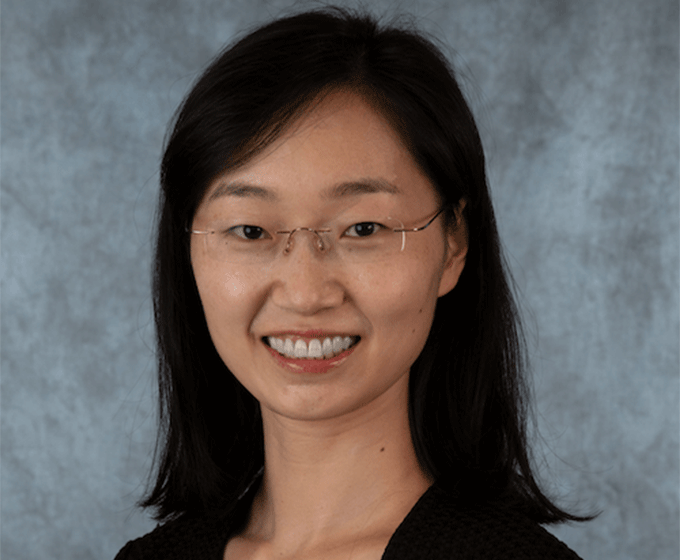
OCTOBER 23, 2023 — Fang Xu, assistant professor in the UTSA Department of Chemistry, was awarded a three-year $509,000 grant from the U.S. Department of Energy (DOE) Office of Basic Energy Sciences. The funding will support doctoral chemistry research into a new material that could potentially become a significant source of renewable energy.
The funding comes from the DOE’s Funding for Accelerated, Inclusive Research (FAIR)—a $37 million initiative that supports minority-serving and emerging research institutions. FAIR will fund 52 projects at 44 institutions and aims to build research capacity, infrastructure and expertise at institutions with historically underrepresented populations. Of the 44 institutions selected for FAIR, UTSA is one of eight that is a Hispanic Serving Institution (HSI).
Xu is the lead principal investigator (PI) in the project, entitled, "Atomic Level Structure-activity Relationship of Small Molecule Activation on Single Atom Catalysts Supported on 2D Boron-based Materials.” She will collaborate with Darío J. Stacchiola, a research group leader in the Center for Functional Nanomaterials at Brookhaven National Laboratory (BNL).
The team will study borophene, which is a two-dimensional form of boron. Boron is a chemical element that exists naturally in many common foods like apples, broccoli and coffee. Borophene is a single form of the chemical that is very concentrated and compact like a sheet of paper. It also contains unique magnetic and electronic properties, which means it has the potential to produce significant amounts of renewable energy in a way that is both low-cost and efficient. Borophene is also a very superconductive material with possible applications in electronics, energy conversion and digital storage.
“We’re in the early stages of unlocking borophene’s full potential, as it’s a novel material with many potential applications,” said Xu, who is a faculty member in the UTSA College of Sciences. “In the past, studies have focused on its physical properties, but my research team will seek to now understand how it can be used as a catalyst in numerous chemical reactions.”
The researchers will analyze borophene at the microscopic level, visualize the atomic structure of its surface and measure its reaction with small molecules like hydrogen and carbon dioxide.
UTSA chemistry doctoral students Kevin Sutherlands and Jennifer Sanchez will work with Xu. They will gain hands-on experience with the ultrahigh vacuum housed scanning tunneling microscope (STM)—a type of microscope that can take images of individual atoms on a surface—at the UTSA Xu Lab, which studies chemical reactions on surfaces and interfaces at an atomic level.
They will work at the Xu Lab for six months, and then complete another six months of research training at BNL, where they will work at state-of-the-art facilities such as with the Center of Functional Nanomaterials (CFN) and National Synchrotron Light Source II (NSLS-II), one of the most advanced circular particle accelerator facilities in the world capable of studying materials at a nanoscale resolution.
“Kevin and Jennifer will receive hands-on training and work directly with leading scientists,” said Xu.
UTSA Today is produced by University Communications and Marketing, the official news source of The University of Texas at San Antonio. Send your feedback to news@utsa.edu. Keep up-to-date on UTSA news by visiting UTSA Today. Connect with UTSA online at Facebook, Twitter, Youtube and Instagram.
Move In To COLFA is strongly recommended for new students in COLFA. It gives you the chance to learn about the Student Success Center, campus resources and meet new friends!
Academic Classroom: Lecture Hall (MH 2.01.10,) McKinney Humanities BldgWe invite you to join us for Birds Up! Downtown, an exciting welcome back event designed to connect students with the different departments at the Downtown Campus. Students will have the opportunity to learn about some of the departments on campus, gain access to different resources, and collect some giveaways!
Bill Miller PlazaCome and celebrate this year's homecoming at the Downtown Campus with food, games, giveaways, music, and more. We look forward to seeing your Roadrunner Spirit!
Bill Miller PlazaThe University of Texas at San Antonio is dedicated to the advancement of knowledge through research and discovery, teaching and learning, community engagement and public service. As an institution of access and excellence, UTSA embraces multicultural traditions and serves as a center for intellectual and creative resources as well as a catalyst for socioeconomic development and the commercialization of intellectual property - for Texas, the nation and the world.
To be a premier public research university, providing access to educational excellence and preparing citizen leaders for the global environment.
We encourage an environment of dialogue and discovery, where integrity, excellence, respect, collaboration and innovation are fostered.